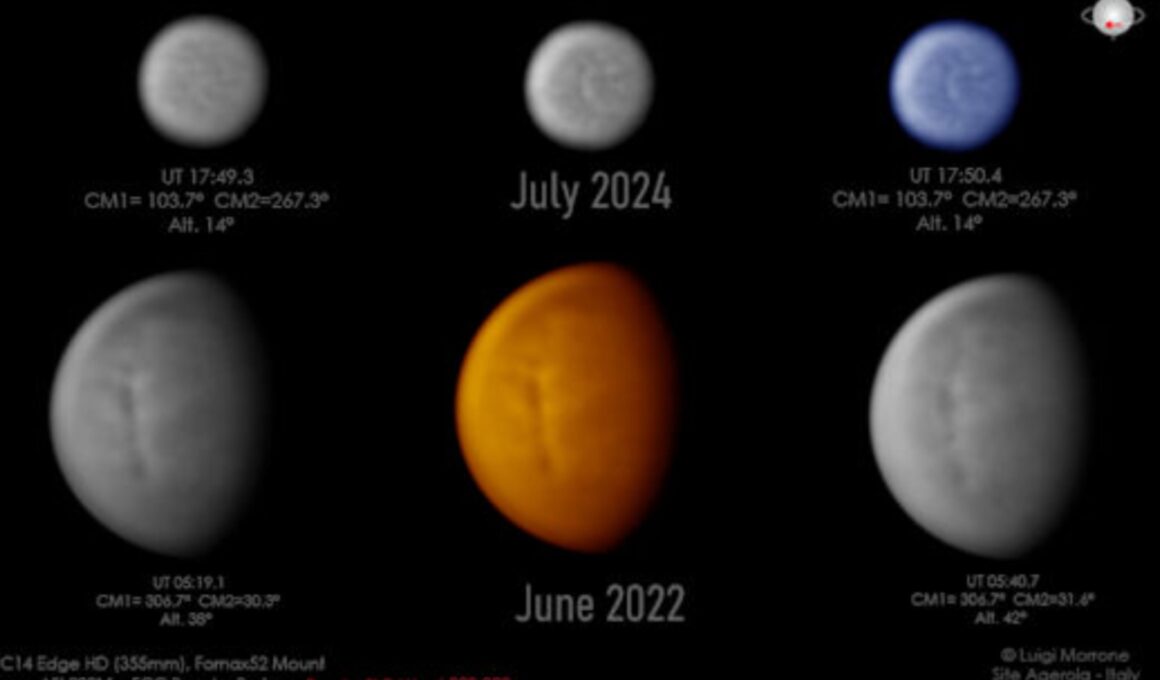A strange, gargantuan wall of acid-filled clouds on our neighboring planet Venus has been spotted by a hobbyist astronomer.
This structure, known as the Venus Cloud Discontinuity, is around 5,000 miles long, cutting across Venus’ equator, and hovers about 30 and 35 miles above the surface.
The bizarre wall was only first discovered in 2016 by Japan’s Venus orbiter Akatsuki.
Now, amateur astronomer Luigi Morrone—who hadn’t seen it since 2022—has photographed it from Agerola, Italy, on July 17th.
The discontinuity appears as a sharp contrast in the cloud patterns, forming a wavelike structure that travels westward around the planet. This structure can be detected in ultraviolet and visible wavelengths, making it observable through various spacecraft and ground-based telescopes. It moves at an extremely high speed, completing a full circuit around the planet in about five Earth days—much faster than the planet’s own 243-day rotation.
The Venus Cloud Discontinuity is thought to have existed since around the 1980s, traveling around the planet at about 205 miles per hour, according to NASA.
“It has been observed on Venus since the very first nightside observations in the K-band performed in the decade of the 1980s, but we identified it for the first time using the Akatsuki/IR2 images which had a very good spatial resolution. In fact, a revisit of the Venus Express data confirmed that it was also present on Venus during the years 2006-2008,” Japan Aerospace eXploration Agency (JAXA) scientist Javier Peralta, who first spotted the structure, told Newsweek.
We still aren’t entirely sure why the wall formed, or how what drives its exceptionally fast journey around the planet.
“This atmospheric disruption is a new meteorological phenomenon, unseen on other planets,” Peralta told spaceweather.com. “We’re still not certain what it is.”
Venus is the hottest planet in the solar system, despite not being the closest to the Sun, with a surface temperature of around 870 degrees F on average. This is due to its immensely thick atmosphere, which is primarily made of CO2, with a layer of sulfuric acid clouds between 30 and 40 miles or so above the surface. This atmosphere also means that the surface pressure on Venus is exceptionally high, at around 92 times that of Earth’s.
Interestingly, Venus’s atmosphere rotates much faster than the planet itself, with winds reaching speeds of up to 224 mph in the cloud tops—a phenomenon known as “super-rotation.”
Peralta suggested that the Venus Cloud Discontinuity could be a link between the planet’s surface and its fast-moving clouds.
“This atmospheric disruption is a new meteorological phenomenon, unseen on other planets. Because of this it is yet difficult to provide a confident physical interpretation, but we do not have doubts that its cyclical effects over the clouds’ properties and distribution of atmospheric aerosols are key pieces missing to complete the complex puzzle of Venus,” Peralta said in a NASA statement in 2020.
“We may have finally found a wave able to transport momentum and energy from the deep atmosphere (precisely where NASA‘s Pioneer Venus probes found that Venus stores most of the atmospheric angular momentum) to the upper clouds where it would dissipate.
“It would, therefore, bring momentum precisely up to the level where we observe the fastest winds of the atmospheric super-rotation of Venus, whose mechanisms have been a longtime mystery.”
The strange wall isn’t always present, Peralta explains, rather disappears and reappears randomly
“Note that it’s not a permanent atmospheric phenomenon on Venus, but a ‘recurrent’ one (like El Niño or La Niña on the Earth), though we don’t know yet how it is produced or when it will be visible,” Peralta said.
“We suspect it is an atmospheric wave (a Kelvin-type wave) because it propagates faster than the super-rotating winds and because it seems to dissipate before arriving at the top of the clouds (and this is the reason why we do not observe it in ultraviolet images of Venus).
“We suspect that it is generated somewhere below the clouds, probably transporting atmospheric momentum from the largest reservoir of Venus to the top of the clouds where we precisely find the fastest super-rotating winds. The discontinuity manifests sometimes very strongly and others very weakly.”
“It seems that it has also showed up (not so strongly) in November 2023, and January-February 2024,” Peralta said.
Ever since we lost contact with Akatsuki in May this year, astronomers like Morrone have been essential to keeping an eye on Venus Cloud Discontinuity
“Unfortunately, we recently lost contact with Akatsuki so images from amateur astronomers are our only source of information,” said Peralta. “Because the discontinuity may propagate faster than the super-rotating winds of Venus, it is critical that observers from different geographical regions provide images to accurately track its motion and confirm its wave nature.”
Do you have a tip on a science story that Newsweek should be covering? Do you have a question about Venus? Let us know via science@newsweek.com.
Uncommon Knowledge
Newsweek is committed to challenging conventional wisdom and finding connections in the search for common ground.
Newsweek is committed to challenging conventional wisdom and finding connections in the search for common ground.








